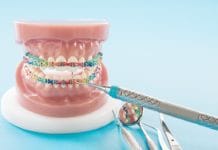Crypt. It sounds like something one would visualize in a horror story. For some, tonsil crypts can be a kind of horror story as they become infested with tonsil stones, causing unwanted malodor even after thorough brushing, tongue scraping, interdental cleaning, and rinsing. This can become a frustrating concern for many people.
Dental hygienists can provide a variety of recommendations to patients regarding tonsil stones, including nutritional guidance.
What are tonsil stones?
Tonsil stones, also known as tonsilloliths, are accumulative accretions of bacterial deposits, dead cells, mucus from chronic sinus drainage, and food particulates that calcify in the deep crypts of tonsils. Tonsil stones have a malodor that can be quite offensive and horrifying for someone who is a chronic sufferer of these stones.
Since our tonsils are filled with deep crypt-like nooks and crannies, the bacteria and dead cells that get trapped into the crypts gather and bond together until they eventually become calcified.1 They will appear whitish-yellow in color and can be minuscule in size to pea-sized or even larger. Since the crypts are irregular in shape and the tonsil stones are of a sticky nature, they can easily become trapped in the tonsils for a significant time.
Chances are that we all have had a tonsil stone of some size at some point. Perhaps you felt like there was something stuck in the back of your throat and inadvertently simply coughed it out or unknowingly expelled it during a voracious sneeze. But what causes the large tonsilloliths to become a chronic problem for some people? Let’s look at what we know about tonsils.
Think of the palatine tonsils as the first line of defense for the immune system.2 They filter out pathogens from entering the body. Consider the location at the back of the palate and the beginning of the throat. It makes perfect sense to have a filter at the beginning of our oral-systemic connector.
Such a filter is put to task defending our immune system against biological pathogens both intrinsically and extrinsically. At some point, the filter (tonsils) simply becomes overwhelmed and reaches max capacity. We will talk about how to clean this filter in a little bit.
Health Factors Behind Tonsil Stones
The role of diets −Diets high in sugar may put an individual at higher risk of developing chronic tonsil stones. As bacteria feed off sugar and multiply exponentially with sugar as a food source, the excessive bacteria can colonize the deep tonsil crypts and thrive in the anaerobic environment. As the tonsils’ crypts become bio-burdened, the overloaded tonsils become like large, clogged pores.
With this in mind, nutritional counseling can help patients have better control over their tonsilloliths. Sugar reduction, as well as the reduction of fermentable carbohydrates, should be encouraged and recommended to prevent tonsilloliths.
Sinus drainage − Chronic sinus drainage can also contribute to tonsil bioburden. Consider recommending a xylitol/saline nasal spray to help keep the sinus and nasal septum clean and clear of bacteria. We will discuss xylitol benefits in a bit.
Mouth breathing, medications, and xerostomia − Nasal issues often lead to mouth-breathing, which results in xerostomia. As the oral cavity becomes dried up, bacteria multiply without adequate saliva as a buffering agent. These excessive bacteria will thrive in the tonsil crypts.
Medication-induced xerostomia is another great challenge in today’s society, so we must look at the medical history for possible answers to help understand each individual’s “why.” Xylitol and saline nasal spray may be a great source of help in the reduction of nasal and oral bacteria and can aid in the production of saliva needed to create a “wash” cycle.3
Compromised immune system− Immunocompromised patients may develop tonsil stones at a greater rate due to the body’s compromised ability to fight off inflammation, bacteria, fungi, and viral infections. The tonsils are filtering in overdrive and simply get overburdened. Think of an air filter trying to clean the air when it is dirty.
Questions for Health History
- What is their diet like? Is it high in sugars or fermentable carbohydrates?
- Ask about their sinus condition. Do their sinuses drain constantly?
- Are they a mouth breather? On medications? Do they have xerostomia?
- Are they immunocompromised? Lupus? Sjogren’s Syndrome? Ailing Arthritis?
- What is their home care like? Do they have good oral hygiene habits and still get tonsil stones?
Helping Your Patients
After a short interview using some of the above questions, you will now have gathered a bit of information to help direct your patient towards a possible solution. A diet high in sugars and carbohydrates will feed the bacteria, and they will multiply exponentially.
Introduce your patients to xylitol as an alternative sugar source. This sugar-alcohol is recognized as a sugar by bacteria, but the larger five-carbon molecule is not able to be metabolized by bacteria.4 As a result, they will stop multiplying and depopulate the tonsils. Recommend xylitol mints, chips, or gum at a dose of five exposures a day.5
If sinuses are chronically draining, however, introduce your patient to a xylitol and saline nasal spray, which will clean the sinus cavity, reduce the bacteria, and help clean the tonsils as the spray drains down the throat. This can be a game-changer, as it may also alleviate mouth breathing and xerostomia.
In immunocompromised patients who develop chronic tonsil stones and report malodor, sore throat, or sore tonsils, recommend a visit to their family doctor for a referral to an ENT. It would be beneficial to still mention xylitol as a preventive of further tonsil stone development.
Removing Tonsil Stones
This is a tricky matter. Caution is advised. Patients can take a Q-tip and gently press against the tonsils using pressure to encourage tonsil stone removal. They can also use a finger and carefully press the tonsils to “milk” out stones.
They may ask you or the dentist for help; however, this is not an area of comfort for me. Tonsil stones that become engorged and refuse to leave should be addressed by a medical doctor or, better yet, an ENT.
Gargling and rinsing with warm salt water can prevent tonsil stones as it cleans the tonsils. As some people actually get a sore throat from the stones, the warm salt water will comfort their throat as it reduces bacteria.
Viewing Tonsil Stones on a Panorex?
Tonsil stones are occasionally calcified enough and large enough to be detected via panorex imagery. Tonsilloliths are viewed as defined radiopaque lesions, often in clusters on the mandibular ramus. It is important to determine that the image on the panorex is, in fact, tonsil stone(s) as other health conditions may show similarly on panorex. Certain malignancies, lymph node and salivary gland calcifications, tuberculosis, or even arterial blockage may appear similarly on panorex. Familiarize yourself with panorex imagery to prevent misdiagnosis and/or unnecessary referrals.6
Most patients are not going to ask you about their tonsil stones, but some will schedule an emergency dental appointment because they are concerned for their health. Assure them that tonsil stones are quite normal and discuss the information mentioned above. The most common concern patients will bring to the table is halitosis − disgust at the smell of a tonsil stone that has been dislodged or coughed out or fear that their health is in jeopardy.
Before you leave, check out the Today’s RDH self-study CE courses. All courses are peer-reviewed and non-sponsored to focus solely on high-quality education. Click here now.
Listen to the Today’s RDH Dental Hygiene Podcast Below:
References
- Tonsil Stones (Tonsilloliths). (n.d.). WebMD. Retrieved from https://www.webmd.com/oral-health/guide/tonsil-stones-tonsilloliths-treatment-and-prevention#1-1
- How Do the Tonsils Work? (2019, January 17). Institute for Quality and Efficiency in Health Care (IQWiG). Retrieved from https://www.ncbi.nlm.nih.gov/books/NBK279406/
- Riley, P., Moore, D., Ahmed, F., Sharif, M., Worthington, H. Xylitol-containing Products for Preventing Dental Caries in Children and Adults. The Cochrane Database of Systemic Reviews. 2015: (3)CD010743. Retrieved from https://www.cochranelibrary.com/cdsr/doi/10.1002/14651858.CD010743.pub2/full
- Keukenmeester, R.S., Slot, D.E., Rosema, N.A.M., Van Loveren, C., Vander der Weijden, G.A. Effects of Sugar-free Chewing Gum Sweetened with Xylitol or Maltitol on the Development of Gingivitis and Plaque: A Randomized Clinical Trial. International Journal of Dental Hygiene. 2014; 12(4): 238-244. Retrieved from https://www.ncbi.nim.nih.gov/pubmed/24650323
- Makinen, K.K. Can the Pentitol-hexitol Theory Explain the Clinical Observations Made with Xylitol? Medical Hypothesis. April 2000; 54(4): 604-613. Retrieved from https://www.sciencedirect.com/science/article/pii/S0306987799909040?via%3Dihub
- Ghabanchi, J., Haghnegahdar, A., Khojastehpour, L., Ebrahimi, A. Frequency of Tonsilloliths in Panoramic Views of a Selected Population in Southern Iran. Journal of Dentistry (Shiraz, Iran). 2015; 16(2): 75–80. Retrieved from https://www.ncbi.nlm.nih.gov/pmc/articles/PMC4445855/
















